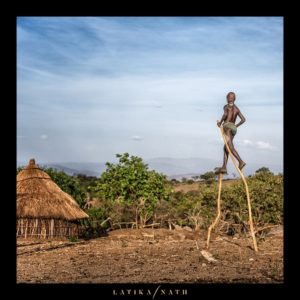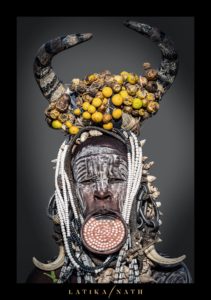It all began three years ago – Latika wanted to visit Ethiopia to photograph the rarest wolf in the world. With less than 400 alive in the wild, as a carnivore biologist, Latika had always wanted the opportunity to study these animals in their natural habitat. Her list grew as she planned her visit to include the Hyaenas of Harar, the gelada baboons, the Abyssinian owl, the Rock Churches of Lalibela and Lucy. As she explored the possibility of visiting Hadar, Latika discovered references to the Tribes of the Omo Valley. Very quickly her inbox was filled with conversations about planning a trip to Omo and discussing the possibility of photographing the incredible people who lived there.

Living in and around the Mago and Omo National Parks are some of the oldest tribes known to man. These tribes continue to live in much the same manner over hundreds of years. The eight tribes, Hamer, Bana, Mursi, Suri, Kara, Dassanech, Arbore and Nyangatom number only about 200,000 in toto. With modern development knocking at their doorstep, the tribes face changes they had never imagined.
In multiple visits, over two years, Latika has taken over 60000 images in Ethiopia. This incredible database of the people, their culture, customs and lifestyle is unique and reveals aspects of their lives seldom revealed to the world. Documenting the Donga, Bull Jumping, fashion, body scarification and decoration, lip and ear plates, blood drinking, their song and dances, rituals and ceremonies, their unique architecture, and food vessels as well the importance of the AK 47 and guns in their lives, Latika has been working on a 5 volume book series which will be launched at the Jaipur Literary Book Festival as a Boxed Set.

Breathtaking landscapes, incredible images of men and women of extraordinary beauty, of children of nature who are masters of body art, the OMO collection is a story that has never been told in quite this fashion and detail.
Omo Fashion is another extraordinary study – where broken watch straps are de rigueur for the fashionista, where gas pipes, bottle caps, plastic tubes, miscellaneous keys, and even a bicycle chain are fashion accessories and different colored metal bullets are melted and made into bangles and earrings. Headdresses are devised from flowers, fruit and leaves and bodies are canvasses for artistry painted using natural pigments. Beads are an essential part of the adornment and goat and even cheetah skin is embroidered painstakingly to create unique outfits. Ash and thorns are used for creating intricate and elaborate keloid scars to decorate bodies. The human body is used as a canvas for body art that is quite breathtaking.

For Latika, this was a life-changing experience. Planning the trips required upto a year of work, allowing her to venture into areas where there are very few visitors from the outside world. She worked in temperatures of over 45C, drove hours each day to get to the villages, was shot at by an AK 47, hung out of planes, lived in tents or homestays in the remotest villages in order to learn about these people. The story of her journeys forms a part of her book – OMO.
The Exhibition at the Bikaner House is the first of her solo shows on OMO and will feature over 150 surreal images from her collection. The exhibition is supported by The Embassy of the Federal Democratic Republic of Ethiopia, New Delhi.
About Dr. Latika Nath
Latika is one of the first wildlife biologists with a D.Phil on Tiger Conservation and Management from the University of Oxford.
She is the first woman wildlife biologist in India to work on tigers and entered the field of tiger conservation at a time when no holistic scientific work had been done on the tiger in India apart from a study in 1968 by American Scientist, George Schaller. Breaking into what had been so far, an exclusively male-dominated field, Latika has spent over twenty-five years working at the grassroots level for tiger conservation. She eventually shifted her focus from academia to working with the tribal communities in the buffer zone of the Kanha Tiger Reserve and the Forest Department of the Government of India for tiger conservation. She lived and worked in the Kanha Tiger Reserve for over a decade where she worked on education, health, art, and alternate energy programs for the tribal villages in the region.
Her life and work have been featured on National Geographic television in a documentary called ‘The Tiger Princess’ and on the Discovery Channel in the program ‘Wild Things’. She contributed to films like ‘Sita’s Story’ and a ‘Tale of Two Tigers’ on the BBC, as well as the cover story on tigers for the ‘Year of the Tiger’ special in 2000. She has worked with numerous international organisations including IUCN, UNDP, UNFPA and ICIMOD on many species including the Asian Elephant, the Gangetic Dolphin, the Arna or Wild buffaloes, and high-altitude mammals in the Kanchenjunga area. Her areas of interest include landscape ecology and the resolution of human-wildlife conflict.
Latika is the recipient of scholarships including the Chevening Award from the Foreign and Commonwealth Office, the Oxford and Cambridge Society of India, the Overseas Research Student (ORS) UK, and the Wildlife Institute of India. She has also been awarded for her work in the field of Eco Tourism by the Adventure Tour Operators Association of India (ATOI).
For the past few years, Latika has been traveling and photographing the cat species of the world. She has photographed tigers, lions, cheetahs, jaguars, snow leopards and clouded leopards. She is an ardent traveler, photographer, and diver and spends time exploring the myriad wilderness spaces of our planet. She has recently published a coffee table book called “Hidden India” on the wildlife and wilderness spaces of India which received wide acclaim.
Latika is a Nikon Professional Member and works closely with Nikon in India.
